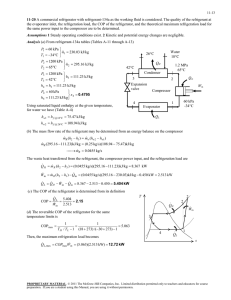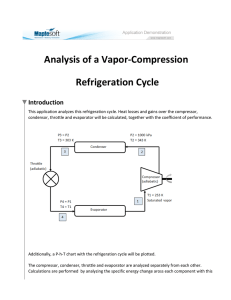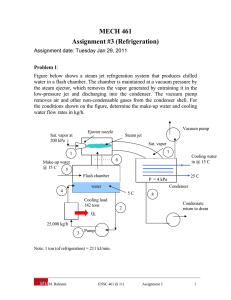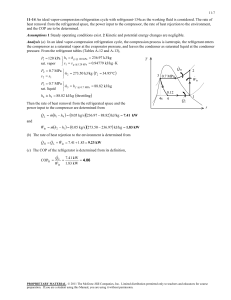International Journal of Scientific Research in Science
advertisement
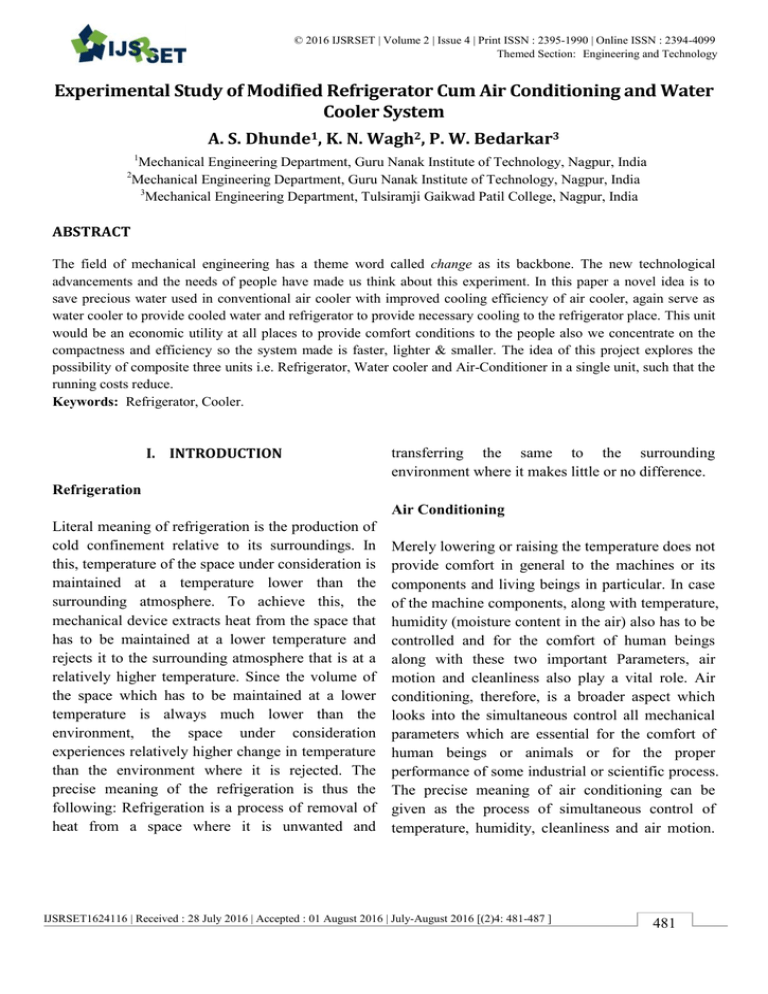
© 2016 IJSRSET | Volume 2 | Issue 4 | Print ISSN : 2395-1990 | Online ISSN : 2394-4099 Themed Section: Engineering and Technology Experimental Study of Modified Refrigerator Cum Air Conditioning and Water Cooler System A. S. Dhunde1, K. N. Wagh2, P. W. Bedarkar3 1 Mechanical Engineering Department, Guru Nanak Institute of Technology, Nagpur, India Mechanical Engineering Department, Guru Nanak Institute of Technology, Nagpur, India 3 Mechanical Engineering Department, Tulsiramji Gaikwad Patil College, Nagpur, India 2 ABSTRACT The field of mechanical engineering has a theme word called change as its backbone. The new technological advancements and the needs of people have made us think about this experiment. In this paper a novel idea is to save precious water used in conventional air cooler with improved cooling efficiency of air cooler, again serve as water cooler to provide cooled water and refrigerator to provide necessary cooling to the refrigerator place. This unit would be an economic utility at all places to provide comfort conditions to the people also we concentrate on the compactness and efficiency so the system made is faster, lighter & smaller. The idea of this project explores the possibility of composite three units i.e. Refrigerator, Water cooler and Air-Conditioner in a single unit, such that the running costs reduce. Keywords: Refrigerator, Cooler. I. INTRODUCTION transferring the same to the surrounding environment where it makes little or no difference. Refrigeration Air Conditioning Literal meaning of refrigeration is the production of cold confinement relative to its surroundings. In this, temperature of the space under consideration is maintained at a temperature lower than the surrounding atmosphere. To achieve this, the mechanical device extracts heat from the space that has to be maintained at a lower temperature and rejects it to the surrounding atmosphere that is at a relatively higher temperature. Since the volume of the space which has to be maintained at a lower temperature is always much lower than the environment, the space under consideration experiences relatively higher change in temperature than the environment where it is rejected. The precise meaning of the refrigeration is thus the following: Refrigeration is a process of removal of heat from a space where it is unwanted and Merely lowering or raising the temperature does not provide comfort in general to the machines or its components and living beings in particular. In case of the machine components, along with temperature, humidity (moisture content in the air) also has to be controlled and for the comfort of human beings along with these two important Parameters, air motion and cleanliness also play a vital role. Air conditioning, therefore, is a broader aspect which looks into the simultaneous control all mechanical parameters which are essential for the comfort of human beings or animals or for the proper performance of some industrial or scientific process. The precise meaning of air conditioning can be given as the process of simultaneous control of temperature, humidity, cleanliness and air motion. IJSRSET1624116 | Received : 28 July 2016 | Accepted : 01 August 2016 | July-August 2016 [(2)4: 481-487 ] 481 In some applications, even the control of air pressure falls under the purview of air conditioning. It is to be noted that refrigeration that is control of temperature is the most important aspect of air conditioning. Figure 2. VCRS Cycle About VCRS Compression Process: Figure 1. CAD Model of Refrigeration cum Air Conditioner and Water Cooler unit II. METHODS AND MATERIAL This Project consists of 3 different Units: [1] Refrigeration unit [2] Water Cooler unit [3] Air Cooler unit All these units working on VCRS having the main dual components are Compressor, Evaporator, Condenser, and Capillary Tube. Figure 3. Compressor The refrigerant being absorb to the compressor through the suction line. Afterward the refrigerant compressed into the compressor and the compressed refrigerant being discharged to the condenser unit through the discharge line. Condensation: Figure 4. Condenser International Journal of Scientific Research in Science, Engineering and Technology (ijsrset.com) 482 When the high pressure refrigerant vapour enters the condenser heat flows from condenser to cooling medium thus allowing vaporized refrigerant to return to liquid state. Expansion: Figure 6. Refrigeration Unit Water Cooler Unit Figure 5. Capillary Tube After condenser the liquid refrigerant is stored in the liquid receives until needed. From the receiver it passes through an expansion value where the pressure is reduced sufficiently to allow the vaporization of liquid at a low temperature. Vapourisation Figure7. Water Cooler Unit The low pressure refrigerant vapour after expansion Water cooler unit consist of evaporator coil made in the expansion valve enters the evaporator on by using Aluminium and copper as a material. In refrigerated space where a considerable amount of this unit refrigerating effect is produced by heat is absorbed by it and refrigeration is furnished. evaporarator is further used by normal water to cooled itself while passing through the chamber. Refrigeration Unit Refrigeration unit is the space provided in the system which is being used to keep the things for cooling, the process is basically a space cooling, outer part of refrigerator is made by GI sheet while Thermocol is used in Refrigerator space as proofing agent to avoid unnecessarily leak of cooling effect from space. Air Cooler Unit Air cooler unit consist of evaporator placed behind fan, evaporator is used to produce refrigerating effect to cooled the surrounding air at lower temperature then by using exhaust fan cooled air is fed out. International Journal of Scientific Research in Science, Engineering and Technology (ijsrset.com) 483 Observation Table II Figure 8. Air Cooled Unit Project Model tested Output for VCRS Cycle Observation Table I Observation Table III Where, Pe -evaporator Pressure in bar Pc- compressor pressure in bar T1 - temperature at evaporator inlet in C. International Journal of Scientific Research in Science, Engineering and Technology (ijsrset.com) 484 T2- temperature at compressor inlet C. T i C. T4 - temperature at expansion valve inlet C. Tw - cold water temperature in C. Tr - regrigerator duct temperature in C. Ta - cold air temperature in C. III. RESULTS AND DISCUSSION Sample Calculation: For observation Table I (For 300 Sec time) At no load Condition 3. Coefficient of performance (COP) Net refrigerating Effect = --------------------------------Heat of Compression = 152.36/38.34 = 3.97 4. Heat rejected in condenser = (h2 –h3) = 412.5 – 221.8 =190.7 KJ/Kg Comparison of project output by graph For Observation Table I and II : Ambient Temperature T0 =35 ᵒC Compressor suction temperature T 1= 31 ᵒC Compressor Discharge Temperature T2 = 36 ᵒC Condensing Temperature T3 =29 ᵒC Evaporator Temperature T4 = 23 ᵒC Pressure Compressor Discharge Pressure (Pc) = 5 bar Evaporator pressure (Pe) = 0.5 bar Refrigerating Effect Temperature Cycle I Cycle II 200 150 100 50 0 Time (Sec) From pressure enthalpy Chart for r 134a, enthalpy values at state points 1, 2, 3, 4. The state points are fixed using pressure and temperature and each point. Calculations Performance Parameters 1. Net Refrigerating Effect (NRE) = (h1 – h4) = 374.16 – 221.80 = 152.36 KJ/Kg 2. Heat of compression = (h2 – h1 ) = 412.5 – 374.16 = 38.34 KJ/Kg Compressor Work h1 =374.16 KJ/Kg h2 =412.5 KJ/Kg h3 =221.80 KJ/Kg h4 =221.80 KJ/Kg Figure 9. Time Vs Refrigerating effect Cycle I 70 60 50 40 30 20 10 0 Cycle II Time (Sec) Figure 10. Time Vs Compressor Work International Journal of Scientific Research in Science, Engineering and Technology (ijsrset.com) 485 Heat Rejected Cycle I Cycle II 195 Design of the system based on condenser, evaporator, and compressor. Which is help in cooling the room area also system have light weight and portable with high energy efficiency. The air cycle provides good outcomes with optimum efficiency. This combine Air conditioning cum Refrigeration system by utilizing conventional method gives required efficiency in terms of COP. 190 185 180 175 170 165 V. REFERENCES Time (Sec) Figure 11. Time Vs Heat Rejected Cycle I COP 4.5 4 3.5 3 2.5 2 1.5 1 0.5 0 Cycle II Time (Sec) Figure 12. Time Vs COP For Observation Table III : Temperature IV. CONCLUSION 30 25 20 15 Tw 10 Tr 5 Ta 0 300 600 900 12001500 180 Time (Sec) Figure 13. Time Vs Temperature [1] L.O.S. Buzelina, S.C. Amicoa, Experimental development of an intelligent refrigeration system. International Journal of Refrigeration 28 (2005) 165–175. [2] U. V. Kongre, M. B. Salunkhe, A. A. Pohekar, Design Methodologies of air-conditioner cum water dispenser, International Journal of scientific research and management (IJSRM) ,Volume1,Issue 1, Pages 18-22 ,2013. [3] S.A. Tassou, T.Q. Qureshi, Performance of a variable-speed inverter motor drive for refrigeration applications, Compute Control Eng J 5 (4) (1994) 193–199. [4] M.Fande, A. M. Andhare, Experimental Investigation and Performance Evaluation of a Three in one Vapour Compression System using Refrigerant R134a, International Journal of Engineering Research & Technology, Volume 4, Issue 05, Pages 1109-1112 May-2015. [5] Prof. S. K. Gupta, Feasibility Study and Development of Refrigerator cum Air Conditioner, International Journal of scientific and research publication, Volume 4, Issue 12, December 2014. [6] S. A. Nada, Performance analysis of proposed hybrid air conditioning humidificationdehumidification system for energy saving and water production in hot and dry climatic region, Energy Conversion and Management, Volume 96, May 2015, Page No. 208-227. [7] J. K. Dabas, A. K. Dodeja, Performance Ch i i f “V Compression R f ig i Sy ” U R T i Conditions, International Journal of Advancements in Technology, Vol. 2 No. 4, October 2011. [8] Tarang Agarwal, Cost-Effective COP Enhancement of a Domestic Air Cooled Refrigerator using R- International Journal of Scientific Research in Science, Engineering and Technology (ijsrset.com) 486 [9] [10] [11] [12] [13] [14] [15] [16] [17] 134a Refrigerant, International Journal of Emerging Technology and Advanced Engineering, Volume 4, Issue 11, November 2014. M. R. Abdelkader, Efficiency of Free Cooling Technique in Air Refrigeration Systems, Jordan Journal of Mechanical and Industrial Engineering, Volume 4, Number 6, December 2010, Pages 711 – 724. Raman Kumar Singh, Design and Fabrication in one air conditioning, International Journal of Research in Computer Applications and Robotics, Vol. 3, Issue 6, Pages 8-14, June 2015. Dr.U. V. Kongre, Testing and Performance Analysis on Air Conditioner cum Water Dispenser, International Journal of Engineering Trends and Technology (IJETT), Volume4, Issue4, April 2013. K. Nagalakshmi, G. Marurhiprasad Yadav, The design and performance analysis of refrigeration system using R12 & R134a refrigerants, International Journal of Engineering Research and Applications, ISSN 2248-9622,Vol.4,Issue 2(Version 1), February 2014, Page No. 638-643. Vivek Sahu, Pooja Tiwari, K.K Jain and Abhishek Tiwari, Experimental Investigation of the Refrigerator Condenser by varying the fin spacing of the condenser,International Journal of Mechanical Engineering and Robotics, ISSN 23215747,Vol.-1,Issue-1,2013. S. C. Walawade, B. R. Barve, P.R. Kulkarni,Design and Development of Waste Heat Recovery System for Domestic Refrigerator, International Journal of Mechanical Engineering and Civil Engineering, ISSN 2278-1684, Page No.28-32. Dr. A. G. Matani, Mukesh K. Agrawal Effect of capillary diameter on the power consumption of VCRS using different Refrigerants, International Journal of Application or Innovation in Engineering & Management, ISSN 2319-4847, Volume 2, Issue 3, March 2013. Jala Chandramouli, C. Shreedhar, Dr.E.V.Subbareddy,Design, Fabrication and Experimental Analysis of Vapour Compression Refrigeration System with Ellipse shaped Evaporator coil, International Journal of Innovative Research in Science, Engineering And Technology, ISSN 2347-6710, VOL.4, August 2015. P. S B b , P f. N. H i B b , “Ex i al Study of A Domestic Refrigerator/Freezer Using Variable Condenser Length, International Journal [18] [19] [20] [21] [22] of Engineering Research And Technology, ISSN 2278-018, Vol. 2, Issue12, December 2013. S. B. Lokhande, Dr. S. B. Barve, Design & Analysis of Waste Heat Recovery System for Domestic Refrigerator, International Journal of Modern Engineering Research, ISSN 22496645,Vol. 4, Issue 5,May 2014. Adrian Mota-Babiloni, Joaquin Navarro-Esbri, Commercial refrigeration- An overview of current Status, International Journal of Refrigeration 57, April 2015, 1 8 6-1 9 6. S.A. Nada, H.F. Elattar, Performance analysis of proposed hybrid air conditioning and humidification dehumidification systems for energy saving and water production in hot and dry climatic regions, Energy Conversion and Management 96 ,(2015) 208–227. Kiyoshi Saito,Latest system simulation models for heating, refrigeration, and air-conditioning systems, and their Applications, International Journal of AirConditioning and Refrigeration, Vol. 20, No. 1 (2012) 1230001 (13 pages). Chengchu Yan, Xue Xue, A novel air-conditioning system for proactive power demand response to smart grid, Energy Conversion and Management 102 (2015) 239–246. International Journal of Scientific Research in Science, Engineering and Technology (ijsrset.com) 487

